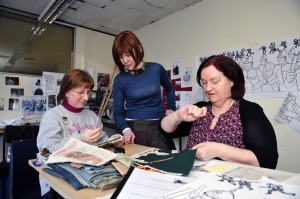Art and the Lockout
Alan Weldon outlines the scope of the recent unusual Nearfm take on the 1913 Lockout

Cathy Henderson, Centre with Volunteers Elizabeth Brennan (left) and Mary Hunter working on the Bloody Sunday Panel of the 1913 Tapestry
Reinterpreting 1913 is a radio series which looked at the Artistic influence that the lockout has had on a number of different artistic disciplines over the past Century. It aims to explore how historical conflict can give creative inspiration to people involved in the Arts.
In Episode 1
We looked at how the media of the time used photographs and cartoons to portray the events of the lockout in a way that positively reflected the workers’ side of the story.
We heard from members of the RADE project who feature in the exhibition and drama “100 years ago”. They talk us through their artistic responses to the lockout in the form of paintings and sculptures and explain their interpretations.
Musician Enda Reilly performed his version of Yeats “September 1913? and talked us through the process of arranging the poem for song. Click on link below for this and other episodes
http://nearfm.ie/podcast/
In Episode 2
Dr. Margarita Cappock tells us about some of the painters involved in the lockout and gives us a sense of their invovlement at the time.
Joe Mooney speaks about Sean O Casey’s connections with East Wall.
Dr. Paul Delaney explores “Strumpet City” and both Paul and NearFMs Michael Sharp discusses the effect the lockout had on these writers works.
We hear excerpts from both “The Plough and the Stars” (performed by the Near Drama Company) and “Strumpet City”.
In Episode 3
We talk to artist Cathy Henderson about the 1913 Tapestry project and her involvement with it.
We speak to Helen Carey (Limerick City Gallery of Art) and Dr. Anthony Haughey about the Troubling Ireland ThinkTank and they tell us what it aims to achieve.
Throughout the programme, all of the above tackle the question of Art as a tool for revolution, both in historical and contemporary times.
Dr James Curry tells us about the James Larkin statue on O’Connell street and The Near Drama Company perform an excerpt from James Plunkett’s 1955 radio drama “Big Jim”.

